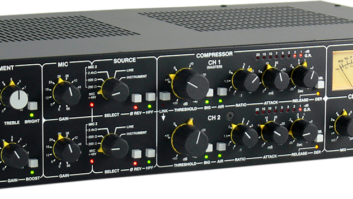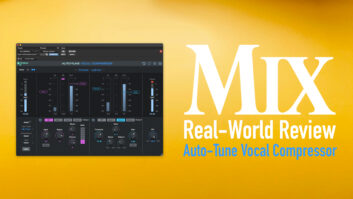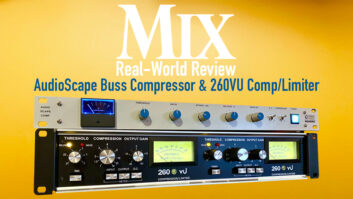
The newest entry in Drawmer’s ‘70s Series product line is the 1970 Dual FET compressor and pre-amplifier. Compared to the original (circa 1985) 2U Drawmer 1960 vacuum tube compressor, the 1970 offers a modern and enhanced toolset that’s more flexible and better suited to the processing requirements of today’s engineer/producers.
Handmade in the UK in a rugged two-rackspace, all-steel chassis with an aluminum front panel, internal construction is solid, with a large main circuit board and daughter boards connected together using short ribbon cables.
A toroidal transformer mounted on the back panel runs the linear power supply, and no surface-mount technology or chip sockets are used. There are also no input or output audio transformers in the 1970. I liked the 6-second time delay before the unit passes audio so no errant noises are emitted while powering up.
Instrument, Microphone Inputs
Like the 1960, the 2-channel Drawmer 1970 works either as two independent mono recording chains with two sets of controls for both Channels 1 and 2, or as a stereo processor with linked controls.
A notable feature in both the 1960 and 1970 units is the single Instrument input section that works like a guitar preamp/tone stack. It has a 1/4-inch input jack and controls on the left side of the front panel.
The high impedance input offers up to 25 dB of gain with an additional 20 dB when the Boost switch is pushed. Voiced like a guitar amp, there are interactive Bass and Treble controls for up ±12 dB using passive equalizers centered at 50–100 Hz and 5 kHz, respectively. This section finishes with an EQ bypass switch and a Bright switch with 12 dB boost in the 2 kHz to 8 kHz range.
Rather than using tubes as in the 1960, the Drawmer 1970 relies on all solid-state circuitry featuring a THAT Corp 1512 low-noise audio preamplifier chip in each mic channel’s preamp section. Each channel has up to 66 dB of microphone gain using a solid-feeling, 12-position, front-panel rotary switch. Gain is selectable in 6 dB steps from 0 dB (unity) up to 66 dB, so an attenuator pad is not required.
Source Select
A Drawmer supplier for 30 years, Lorlin Ltd. makes both the mic Gain and the six-position Source rotary switches. The Source rotary selects which audio input(s) are routed to rest of the 1970’s signal chain(s). Either channel can be for a microphone, instrument input or line-level signal.
Microphones are connected to separate rear-panel XLR connectors. When the Source switch is at fully CCW, it is the Mic +48V position and for phantom-powered microphones only.
Next on the switch are 200, 600 and 2.4-kohm input impedance choices. The 1970 adds the ability to change its input impedance by switching in various resistive loading networks in front of the THAT Corp. chip. This is a way to “sculpt” the sound of passive dynamic, and especially very low-impedance ribbon, microphones.
Position 5 is the Line level input from a separate pair of rear-panel XLR connectors while Position 6 connects the instrument input section’s output. Notably, a thoughtful feature is the ability to route the single Instrument section to both Channels 1 and 2 of the 1970 at the same time for two completely different processing chains of the same source.
Following Source selection are on/off switches for Phase Reverse (polarity flip) and HPF, a 70 Hz, 12 dB/octave filter highpass filter. The original 1960 had no polarity flip.

Compressor Section
After the Phase and HPF buttons is the FET-based compressor section. The 1960 used a similar circuit but with a tube gain output stage. There are no tubes in the 1970, and, also unlike the 1960, there are not any rear-panel TRS insert jacks for connecting an outboard line-level processor (such as an equalizer) before the compressor section.
Both compressor sections have independent controls for processing two separate audio signals. And there is a Link on/off switch for linking the two compressors for proper stereo operation. In this mode, all of Channel 1’s controls, indicator LEDs and Gain Reduction meter represent and apply to both channels to maintain proper stereo imaging. There is a large, easy-to-grab Threshold control knob with a range of –40 dB to +20 dB.
Both Channel 1 and 2 compressor’s side-chains have separate rear-panel, unbalanced send/return insert TRS jacks for external control, such as for de-essing or ducking functionality. This external signal enters the unit before the Threshold control, the Big and Air on/off buttons, and the rest of the control circuitry that develops the compression Ratio, Attack and Release timings.
The Big switch reduces low frequencies present in the side-chain signal for less compression in the bass. Also in the side-chain is the Air switch, which boosts high frequencies that may have been diminished during compression. Both Big and Air are preset with just on/off switches.
The 1970’s separate Ratio controls range from 1:1 to 10:1, Attack ranges from 200 microseconds to 100 milliseconds, and Release is adjustable from 50 ms to 3.5 seconds. I liked the PGM switch for program-dependent release timing—it is a good starting point when using the 1970 during a fast-paced recording session. The Compressor section finishes with an eight-segment LED gain reduction meter. It’s bright and easily seen from across the room.
Modern Output
I liked the modern Wet/Dry control that blends the compressor’s input signal with its output for parallel processing. There are separate Gain controls for makeup gain with 0 dB positions. For each channel there are hard-wired Bypass switches that use subminiature relays. Bypass connects the Output amps directly to the input of the compressor.
Another great feature that was not on the 1960 is the somewhat confusingly named Link switch. There is already a compressor Link switch, so this should be called Output Link; it locks the two output Gain amplifiers together, with Channel 1’s control knob as master.
Finally, there is a +10 dB meter Pad button to re-scale the VU meter so 0 VU is actually +10 dB. This great idea keeps the VU meters off the pin when working with hot, modern DAW audio levels. Also an improvement over the 1960, I definitely love the larger, LED-lit VU meters; they read output level only.
In the Studio
I first wanted to hear the effect of the different microphone input impedances available. I used a pair of closely matched Royer R-10 ribbon mics that have a factory recommended load impedance of 700 ohms or higher. I set them up positioned as close together as possible and pointed at the center of the dust cover of the Celestion Hellatone 30 12-inch speaker in my guitar cabinet. Each mic was connected to a separate channel on the 1970, and I used 36 dB of gain, no HPF and bypassed the 1970’s compressor.
As reference, Channel 1 was kept at 2.4 kohms, but for Channel 2, I tried all three impedance choices. As compared to the 2.4 kohm position, the 600-ohm position produced a darker, thicker tone with a lower level, while the 200-ohm position was extremely murky, sludgy and thick, with no air at all.
With both mics on separate tracks, I did like blending the high-fidelity track from Channel 1 with Channel 2’s grungy and fat tonality that was in phase and beefy-sounding. I’m confident with this setup to record a mix of the two mics to one guitar track, and I would change the blend for the double-track.
Next, on a stereo insert in Pro Tools for line-level processing a loud dance track with lots of bass, heavy kick drum and “spikey” percussion elements, I calibrated the 1970. With 0 dB = -18 dBFS 1 kHz tone coming from my interface, and using the two bypass buttons, I quickly matched throughput levels. The Gain controls give a range of –10 dB to +20 dB for this process.
The Drawmer 1970 is a smooth, clean, soft- knee compressor, and I tried various ratios up to 10:1 limiting. I could maintain a constant LUFS easily with a ratio of 5:1, with the gain reduction LEDs sometimes indicating up to 20 dB of gain reduction! Wow! But it certainly didn’t sound like that much squash at all.
The Big function is a must for keeping the low frequencies from triggering excessive gain reduction. I like that the gain reduction meters work all the time, even in bypass—you can tweak a little in bypass and then kick it in!
The Output Link feature works well, and I would recommend starting with it in play for stereo processing; I had trouble matching L/R levels exactly when changing back and forth between it and dual-mono mode.
I recorded a Taylor acoustic guitar using an X-Y coincident stereo matched pair of PreSonus PM-2 cardioid condenser mics. I had the Source switched to Mic+48v to power the mics, and Gain was set to 36 dB. I had the crossed mics close in on this large-body acoustic, and I switched on the HPF. For this setup, the HPF was just right for producing a solid midrange rhythm guitar sound. I compressed lightly with Big and Air processors switched on. I got a super-clear and steady sound using about 2 to 6 dB of compression at a 2:1 ratio, Attack at 10 ms and Release time at 0.3 seconds.
Lead vocals were next, using a new MXL Reference II tube condenser. Not needing phantom power, the mic produced the most level at the 2.4 kohm position. Gain at 42 dB for my mellow and soft singer. I did not use the HPF or Air or Big features for this vocal. Again, the compressor was clean and controlled the level well. This is a clean, uncolored sound for near transparent compression.
I did try the Instrument input for recording the DI output of the Taylor acoustic along with the MXL microphone at the same time. The Instrument input on the 1970 has a lot of gain available, and you can overdrive using the Boost mode.
The Bright mode was too much for this acoustic, but I could see that working well for other instruments. I just bumped the bass knob up a little and checked for polarity between the two sources mixed together. They sounded great. The DI gives an adjustable “edge,” and the large-diaphragm condenser produced all the body.
The Do-Anything Anywhere Recording Channel
The Drawmer 1970 Dual FET compressor and pre-amplifier really is a desert island recording chain that will handle any audio source from line-level to mic to guitars or hotter synths, to low-impedance microphones. It would get much use at my studio!
Product Summary
- Company: Drawmer Electronics Ltd.
- Product: Drawmer 1970 Dual FET Compressor and Pre-Amplifier
- Web: www.drawmer.com
- Price: $1,497 MAP
- Pros: Two amazingly useful channels in a 2U cabinet.
- Cons: The (Output) Link function could be better.







